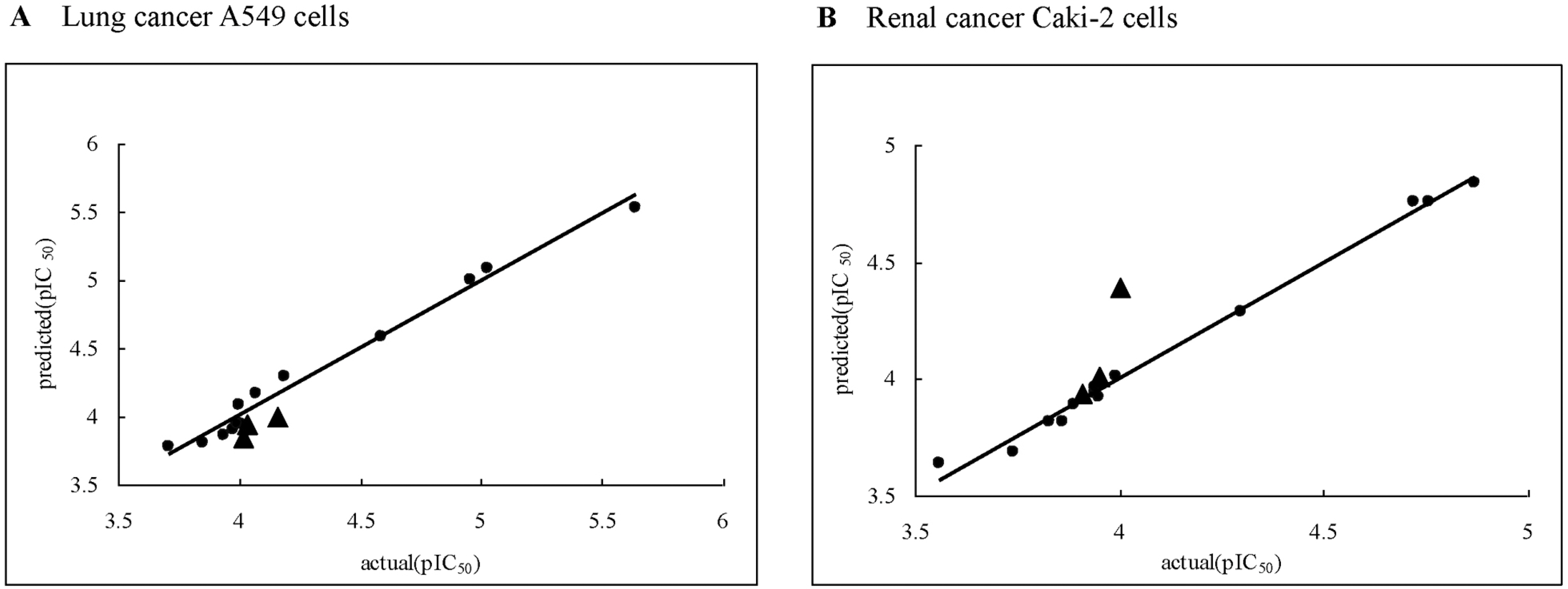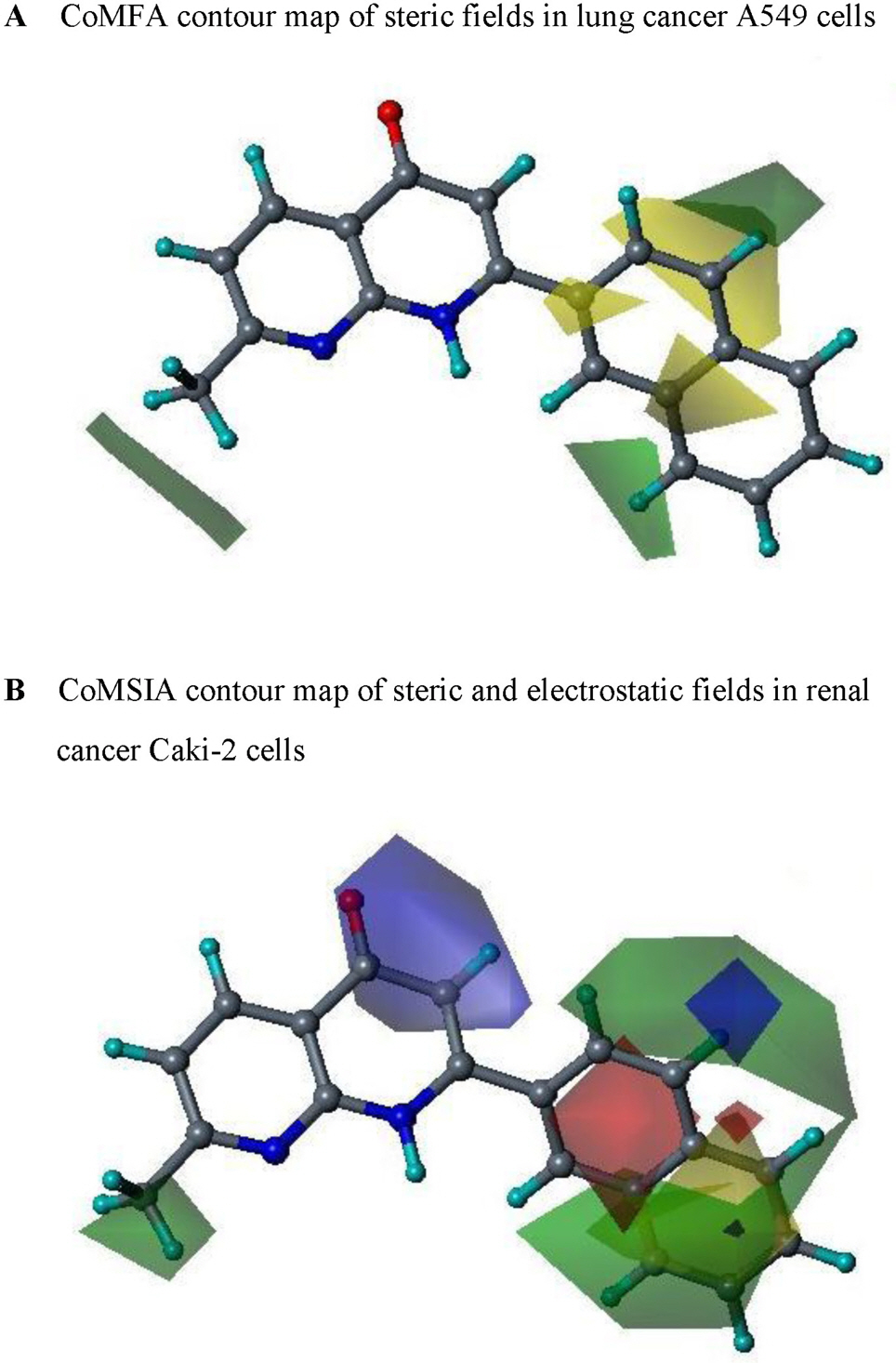Korean J Physiol Pharmacol.
2009 Dec;13(6):511-516. 10.4196/kjpp.2009.13.6.511.
Cytotoxic Activity and Three-Dimensional Quantitative Structure Activity Relationship of 2-Aryl-1,8-naphthyridin-4-ones
- Affiliations
-
- 1College of Pharmacy, Chung-ang University, Seoul 156-756, Korea. Chaeukim@cau.ac.kr
- KMID: 2285389
- DOI: http://doi.org/10.4196/kjpp.2009.13.6.511
Abstract
- A series of substituted 2-arylnaphthyridin-4-one analogues, which were previously synthesized in our laboratory, were evaluated for their in vitro cytotoxic activity against human lung cancer A549 and human renal cancer Caki-2 cells using MTT assay. Some compounds (11, 12, and 13) showed stronger cytotoxicity than colchicine against both tumor cell lines, and compound 13 exhibited the most potent activity with IC50 values of 2.3 and 13.4 micrometer, respectively. Three-dimensional quantitative structure activity relationship (3D-QSAR) studies of comparative molecular field analysis (CoMFA) and comparative molecular similarity indices analysis (CoMSIA) were performed. Predictive 3D-QSAR models were obtained with q(2) values of 0.869 and 0.872 and r(2)(ncv) values of 0.983 and 0.993 for CoMFA and CoMSIA, respectively. These results demonstrate that CoMFA and CoMSIA models could be reliably used in the design of novel cytotoxic agents.
Keyword
- CoMFA; CoMSIA; Cytotoxicity; MTT; QSAR
MeSH Terms
Figure
Cited by 1 articles
-
The Stimulatory Effect of Essential Fatty Acids on Glucose Uptake Involves Both Akt and AMPK Activation in C2C12 Skeletal Muscle Cells
So Yeon Park, Min Hye Kim, Joung Hoon Ahn, Su Jin Lee, Jong Ho Lee, Won Sik Eum, Soo Young Choi, Hyeok Yil Kwon
Korean J Physiol Pharmacol. 2014;18(3):255-261. doi: 10.4196/kjpp.2014.18.3.255.
Reference
-
References
Chen K., Kuo SC., Hsieh MC., Mauger A., Lin CM., Hamel E., Lee KH. Antitumor agents. 174. 2′,3′,4′,5,6,7-Substituted 2-phenyl-1,8-naphthyridin-4-ones: their synthesis, cytotoxicity, and inhibition of tubulin polymerization. J Med Chem. 40:2266–2275. 1997.
ArticleChung ML. Synthesis and Anti-Cancer Activity of 2-Phenyl-1,8-naphthyridine-4-one Derivatives. Chung Ang Graduate School Master thesis. 2004.Hamel E., Lin CM., Plowman J., Wang HK., Lee KH., Paull KD. Antitumor 2,3-Dihydro-2-(aryl)-4(1H)-quinazolinone Derivatives. Interactions with Tubulin. Biochem Pharmacol. 51:53–59. 1996.Hastie SB. Interaction of colchicine with tubulin. Pharmacol Ther. 51:377–401. 1991.Hour MJ., Huang LJ., Kuo SC., Xia Y., Bastow K., Nakanishi Y., Hamel E., Lee KH. 6-Alkylamino- and 2,3-dihydro-3′-methoxy-2-phenyl-4-quinazolinones and related compounds: their synthesis, cytotoxicity, and inhibition of tubulin polymerization. J Med Chem. 43:4479–4487. 2000.
ArticleJackson PL., Scott KR., Southerland WM., Fang YY. Enaminones 8: CoMFA and CoMSIA studies on some anticonvulsant enaminones. Bioor Med Chem. 17:133–140. 2009.
ArticleJordan MA., Wilson L. Microtubules as a target for anticancer drugs. Nat Rev. 4:253–264. 2004.
ArticleKuo SC., Lee HZ., Juang JP., Lin YT., Wu TS., Chang JJ., Lednicer D., Paull KD., Lin CM., Hamel E., Lee KH. Synthesis and cytotoxicity of 1,6,7,8-substituted 2-(4'-substituted-phenyl)-4-quinolones and related compounds: Identification as antimitotic agents interacting with tubulin. J Med Chem. 36:1146–1156. 1993.Lai YY., Huang LJ., Lee KH., Xiao Z., Bastow KF., Yamori T., Kuo SC. Synthesis and biological relationships of 3′,6-substituted 2-phenyl-4-quinolone-3-carboxylic acid derivatives as antimitotic agents. Bioorg Med Chem. 13:265–275. 2005.
ArticleLi L., Wang HK., Kuo SC., Wu TS., Lednicer D., Lin CM., Hamel E., Lee KH. Antitumor agents. 150. 2′,3′,4′,5′,5,6,7-Substituted 2-phenyl-4-quinolones and related compounds: Their synthesis, cytotoxicity, and inhibition of tubulin polymerization. J Med Chem. 37:1126–1135. 1994.
ArticleManthey JA., Guthrie N. Antiproliferative Activities of Citrus Flavonoids against Six Human Cancer Cell Lines. J Agric Food Chem. 50:5837–5843. 2002.
ArticleManthey JA., Guthrie N., Grohmann K. Biological properties of citrus flavonoids pertaining to cancer and inflammation. Curr Med Chem. 8:135–153. 2001.
ArticleNakamura S., Kozuka M., Bastow KF., Tokuda H., Nishino H., Suzuki M., Tatsuzaki J., Morris Natschke SL., Kuo SC., Lee KH. Cancer preventive agents, part 2: synthesis and evaluation of 2-phenyl-4-quinolone and 9-oxo-9,10-dihydroacridine derivatives as novel antitumor promoters. Bioorg Med Chem. 13:4396–4401. 2005.
ArticlePark JG., Kramer BS., Steinberg SM., Carmichael J., Collins JM., Minna JD., Gazdar AF. Chemosensitivity testing of human colorectal carcinoma cell lines using a tetrazolium-based colorimetric assay. Cancer research. 47:5875–5879. 1987.Rieger JM., Brown ML., Sullivan GW., Linden J., Macdonald TL. Design, Synthesis, and Evaluation of Novel A2A Adenosine Receptor Agonists. J Med Chem. 44:531–539. 2001.
ArticleRowinsky EK., Donehower RC. The clinical pharmacology and use of antimicrotubule agents in cancer chemotherapeutics. Pharmacol Ther. 52:35–84. 1992.
ArticleShi Q., Chen K., Li L. Antitumor Agents. 154. Cytotoxic and antimitotic flavonols from Polanisia dodecandra. J Nat Prod. 58:475–482. 1995.
ArticleSYBYL Molecular Modeling Software. Tripos Inc., St. Louis, USA. 2009.Verwij J., Clavel M., Chevalier B. Paclitaxel (Taxol) and docetaxel (Taxotere): Not simply two of a kind. Ann Oncol. 5:495–505. 1994.Xia Y., Yang ZY., Hour MJ., Kuo SC., Xia P., Bastow KF., Nakanishi Y., Nampoothiri P., Hackl T., Hamel E., Lee K H. Antitumor agents. Part 204: Synthesis and biological evaluation of substituted 2-arylquinazolinones. Bioorg Med Chem Lett. 11:1193–1196. 2001.Xia Y., Yang ZY., Xia P., Bastow KF., Tachibana Y., Kuo SC., Hamel E., Hackl T., Lee KH. Antitumor Agents. 181. Synthesis and Biological Evaluation of 6,7,2′,3′,4′-Substituted-1,2,3,4-tetrahydro-2-phenyl-4-quinolones as a New Class of Antimitotic Antitumor Agents. J Med Chem. 41:1155–1162. 1998.
ArticleZhang SX., Bastow KF., Tachibana Y., Kuo SC., Hamel E., Mauger A., Narayanan VL., Lee KH. Antitumor agents. 196. Substituted 2-thienyl-1,8-naphthyridin-4-ones: their synthesis, cytotoxicity, and inhibition of tubulin polymerization. J Med Chem. 42:4081–4087. 1999.
Article
- Full Text Links
- Actions
-
Cited
- CITED
-
- Close
- Share
- Similar articles
-
- Cytotoxic Activity and Quantitative Structure Activity Relationships of Arylpropyl Sulfonamides
- Quantitative Structure Activity Relationship between Diazabicyclo[4.2.0]octanes Derivatives and Nicotinic Acetylcholine Receptor Agonists
- Cytotoxicity and Structure-activity Relationships of Naphthyridine Derivatives in Human Cervical Cancer, Leukemia, and Prostate Cancer
- Characteristics in Molecular Vibrational Frequency Patterns between Agonists and Antagonists of Histamine Receptors
- Cytotoxic Activity and Structure Activity Relationship of Ceramide Analogues in Caki-2 and HL-60 Cells



